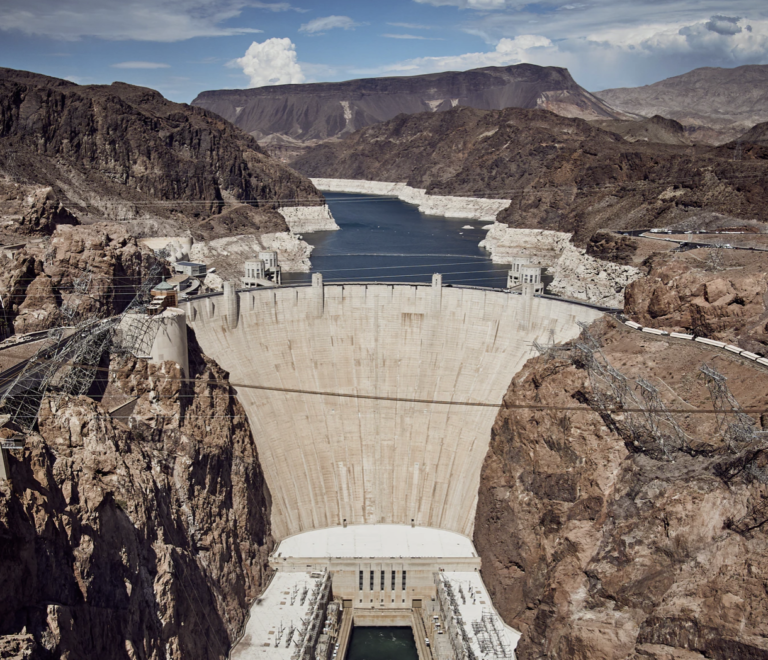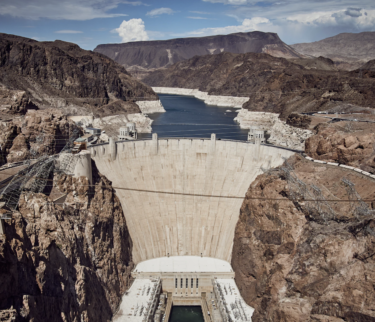はじめに
今日もTED-Edの動画を視聴した。1935年に完成した当時の世界最大規模の建造物でもあるダムだ。興味のある方はまずは次の動画を見てほしい。
(出典:YouTube)
ダムの建設
今回の動画の対象となったのは、世界的な大恐慌の時代である1931年から1936年にかけてコロラド川のブラックキャニオンに建設されたフーバーダムだ。1935年9月30日にフランクリン・D・ルーズベルト大統領によって竣工式が行われました。建設には2,100人の労働者が従事し、100人以上の人命が犠牲になった。ダムが建設されたブラックキャニオンとその近くのボルダーキャニオンに大規模なダムを建設することにより、周辺の洪水を抑制し、農業用の灌漑用水を供給し、さらに需要が増大していた電力発電を行うという3つの課題を一挙に解決することを狙ったものだ。ダム建設は、シックス・カンパニーズというコンソーシアムで受注し、1931年初めに建設開始された。重力式アーチダム、高さ221メートル、長さ379メートルで、このような大規模なコンクリート構造物の建設は、それまでに経験がなく、技術も未確立だった。夏は猛烈に暑い、危険な難工事も多い、十分な設備もない、そんな中で、予定よりも2年以上早い1936年3月1日にダムは連邦政府に引き渡された。ダムが発電した電力は、ネバダ州、アリゾナ州、カリフォルニア州の公共および民間の電力会社に供給されている。ダム完成後の1940年には湛水が原因とされるマグニチュード5の誘発地震が発生している。なお、このダムの貯水量は約400億トンであり、琵琶湖の貯水量が280億トンの約1.7倍と言うのはすごい。
8つの質問
TED-Edを視聴するとその理解度をチェックするための質問が用意されている。参考に付記しておく。
Q1) Which government agency was responsible for building the dam?
これは、干拓局(Bureau of Reclamation)か、陸軍(Army Corps of Engineers)か、国土安全保障省(Department of Homeland Security)かという選択式の質問だ。干拓局だろう。
Q2) Which river was the dam built on?
これはコロラド川だ。
Q3) Which was NOT one of the causes of worker fatalities?
労働者死亡事故の原因を問う問題だ。熱中症(Heat stroke)や一酸化炭素中毒(Carbon monoxide poisoning)はあるが、減圧症(Decompression sickness)は考えにくいし、動画にも出てこない。
Q4) How was the concrete cooling process accelerated?
動画を見ていると細かなモジュールに区切ったところにコンクリートを詰めて、さらに鉄のパイプに水を流して冷やすとある。
Q5) What year was the dam completed?
ダムの完成は1935年だ。政府への正式な引渡しは翌年3月だった。
Q6) What were some of the reasons for building the dam?
ダムを建設した理由は前述の通り、電力需要への対応と、水害の防止と、灌漑用水資源の安定的な利用かな。
Q7) How does an arch-gravity dam work?
上流に向かってカーブし、押し寄せる水の力を利用して構造物を支え、フーバーダムの場合には渓谷の壁に押し付ける仕組みだ。

(出典:土木ウォッチング)
Q8) What were some of the negative impacts of the dam’s construction?
大規模なダムを建設すると、周辺の地域が水没し、生態系が破壊される。さらに、今回だと100名以上の労働者が死亡している。大恐慌で職を求める人の受け皿になったという側面もあるようだけど、現代ではなかなか踏み切れないのではないだろうか。
まとめ
高度成長の時代には、日本でも黒四ダムの建設などがいまも語り継がれる。そして、1935年に完成したフーバーダムはその規模も比較にならないほど大規模なものだった。この動画を見るまで知らなかった。動画を字幕なしで1回や2回見てもなかなかここまで理解は深まらない。やはりディクテーションが重要だと痛感する。なお、英文は巻末に参考として記載するが、意味が難しいと感じた単語は赤字にしておく。特に冒頭に聞きなれない単語が続くが動画を見ているとだいたい類推はできるだろう。
以上
最後まで読んで頂きありがとうございます。
拝
参考:英語のスクリプト
High above the floor of Nevada`s Black Canyon, a group of men repelled down the cliff face. Suddenly, a man stumbled over the canyon rim. He plummeted past the men, too fast for them to grab – when another climber swung out from the rocks and carried him to safety. Once they had repelled the engineer up the cliff, his savior swung back to business as usual – just another day in the construction of the Hoover Dam. In the early 20th century, the United States had expanded from coast to coast, but many cities in the arid southwest still lacked reliable water sources.
While the Colorado River had been diverted into a series of canals, its erratic flow and frequent floods made it unreliable for agriculture. At the same time, the region is growing cities and industries continually needed more energy. So in 1922, the Bureau of Reclamation decided to solve all these problems in one fell swoop by building a massive hydroelectric dam.
Ensuring water rights for the project required unprecedented cooperation using the force of oncoming water to push the structure into its supports – between all seven states along the river. But once local governments agreed, the Bureau determined that Black Canyon`s narrow gorge was best suited for an arch-gravity dam.
This design curves upstream, using the force of oncoming water to push the structure into its supports – in this case, the canyon walls. Arch dams have been built since ancient times, but never on such a massive scale. When complete, the structure would be 221 by 379 meters. It would take an enormous labor force to build a dam this massive. And when the Great Depression struck only a year after the project was approved, thousands of families looking for work began flocking to the site. The earliest arrivals lived in a makeshift encampment called Regtown. With no infrastructure, scarce supplies, and little protection from the elements, several residents died of heatstroke. So to better house workers, the government designed and built the still thriving Boulder City, complete with numerous amenities, including a state-of-the-art hospital. Before construction on the dam could begin, the entire river had to be rerouted. Building these diversion tunnels required blasting into each side of the canyon to create 17-meter tall tubes. With a combined length of almost 5 kilometers, these tunnels could divert roughly 5,600 cubic meters of water per second. However, workers faced grueling conditions to finish these on time, and dozens succumbed to the scorching heat.
By the fall of 1932, the river had been successfully redirected. But the most dangerous work was still ahead. Over 1 million cubic meters of loose rock needed to be cleared from the canyon walls. So foremen brought in high scalers who descended the cliffs on ropes, removing rubble with jackhammers and dynamite.
From circus acrobats and former sailors to local Apache, these death-defying individuals performed some of the most dangerous – and glamorous – work on site. After the walls were cleared, it was finally time to build the dam. The required pouring over 6.6 million tons of concrete – enough to pave a road across the entire US. But so much concrete poured at once would take far too long to cool and harden. So to speed this process up, concrete was poured in interlocking blocks of varying sizes, each containing steel pipes flowing with cold water.
By 1935, most of the structure had been completed two years ahead of schedule. On February 1st, the diversion tunnels opened to fill the dam`s reservoir, capable of holding twice the Colorado River`s annual flow.
Upon completion, the dam was the tallest manmade structure in the world. However, the speed of its construction came at the cost of worker safety. While this project employed roughly 21,000 Americans during a major economic crisis, over 100 people died during construction. Creating the reservoir also destroyed communities like St. Thomas and devastated the Colorado River ecosystem.
Today, the Hoover Dam generates over 4 billion kilowatt-hours annually, providing electricity for over 1.3 million people. But the consequences of its construction continue to cast a shadow over this monumental structure.




